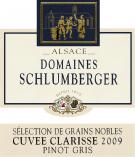History
The Pinot Gris grape variety appeared in Alsace at the end of the 17th century. It varies in colour from grayish blue to brownish pink and is a very close relation of the Burgundian pinot beurot variety. Less fragrant than other varieties it produces a full-bodied, heavy wine which is particularly good when made with over-ripe grapes as it’s the case for our Selection de Grains Nobles wines. Late-harvested, Selections de Grains Nobles Pinot Gris wines are sumptuous and improve by becoming finer in time. Cuvée Clarisse is a very rare wine. Before 2000 it was only produced in 1964, 1989, 1997, and 1998.
Location
Our Pinot Gris Cuvée Clarisse 2009 comes solely from our east facing Grand Cru Spiegel plot, which stretches out halfway up the slope with sandy-clayed soil on marl-sandstone bedrock.
Wine-making
Cuvée Clarisse 2009 comes from a prime choice of Selections de Grains Nobles produced in 2009. Work was monitored right from winter pruning to harvesting which took place the 20th October 2009. Handpicked on steep slopes, the grapes were then carried in crates (to avoid damaging the berries) to our winery and then slowly pressed. After letting the must settle statically for about 3 days, the perfectly clear juice was put in tuns (where the temperature was rigorously controlled) to ferment. Fermentation lasted between 1 and 3 months until spring. The wines were stabilized, filtered and then bottled the 23rd March 2011. They were then stocked for several years before being labeled and distributed all over the world.
Gastronomy
- Can be enjoyed on its own or at the end of a meal with cold desserts.
Tasting
The robe is golden yellow with straw highlights. The disc is thick, bright with a beautiful clarity. The legs are smooth and fatty. The wine allows the light to shine through brightly. The appearance is that of a young concentrated wine.
On the nose, the first sensation is intense with notes of raisins and roasted fruits such as almonds. After aeration, the notes of toasted and cooked sugars are intensified, hazelnuts in caramel in particular, as well as notes of quince jelly and honey. A subtle hint of eucalyptus refreshes the olfactory expression. A nose of elegant subtlety that confirms a noble over-ripeness of the grapes.
The onset on the palate is frank and velvety. A subtle freshness with flavours of candied orange incorporates a honeyed and tender sugar concentration. I rediscovered the typical notes of botrytis like raisin and candied apricot. Exotic flavours of mango and passion fruit give tone to the mid-palate and balance the wine. The length of 6 to 8 caudalies is marked by flavours of red tea and menthol for a palatable final. A very great sweet wine for laying down.






